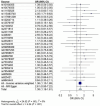Evaluation of the Association Between Postpartum Hemorrhage and Antidepressant Use: A Mendelian Randomization Study
- PMID: 40238033
- PMCID: PMC12173970
- DOI: 10.1007/s40801-025-00490-1
Evaluation of the Association Between Postpartum Hemorrhage and Antidepressant Use: A Mendelian Randomization Study
Abstract
Background: The relationship between antidepressants, depression, and the incidence of postpartum hemorrhage (PPH) has been reported in observational studies, but the causal link between these factors remains unknown. Clarifying this relationship is important for treating depression during pregnancy and managing PPH.
Objective: We aimed to assess the causal relationship between antidepressants, depression, and PPH using a two-sample Mendelian randomization method.
Methods: Single nucleotide polymorphisms were identified from publicly available genetics summary databases (FinnGen database, access date: 28 December, 2023, version R9, phenocode: ANTIDEPRESSANTS, 195,321 participants; the genome-wide association studies [GWAS] catalog, access date: 3 April, 2024, GWAS ID: ebi-a-GCST90016607; Integrative Epidemiological Unit database, access date: 3 April, 2024, GWAS ID: ieu-a-1187) as alternative exposure factors for antidepressants and depression. Subsequently, inverse variance weighting, Mendelian randomization-Egger regression, weighted median, simple method, and weighted method were employed for Mendelian randomization analyses, and the results were validated for pleiotropy, heterogeneity, and sensitivity.
Results: The analyses employed three sets of genetic tools, comprising two sets of 9 and 32 single nucleotide polymorphisms that are strongly associated with depression and another set of 26 single nucleotide polymorphisms that are associated with antidepressants. The inverse variance weighting indicated that antidepressants are associated with PPH (odds ratio = 1.36, 95% confidence interval 1.10-1.69, p = 0.005). Conversely, none of the five methods of Mendelian randomization analysis identified an effect of depression on PPH.
Conclusions: This Mendelian randomization analysis indicated that antidepressant use is associated with PPH. However, the evidence does not support a causal relationship between depression and PPH.
© 2025. The Author(s).
Conflict of interest statement
Declarations. Funding: This work was supported by the Young and Middle-aged Talent Cultivation Projects of Fujian Province, China [grant number 2024GGB27], the Young and Middle-aged Talent Cultivation Projects of Xiamen city, China [grant number 2024GZL-GG10], the National Natural Science Foundation of China [grant number 82304629], Fujian Provincial Natural Science Foundation of China [grant number 2024 J08304], and the Natural Science Foundation of Xiamen, China [grant number 3502Z202371048]. Conflict of interest: Zhenzhen Chen, Qingqing Lv, Shiteng Lin, Wanlong Lin, and Wei Zhuang have no conflicts of interest that are directly relevant to the content of this article. Ethics approval: The data utilized in this study are derived from publicly available GWAS summary data. This research has been conducted using publicly available summary statistics. All original studies have been approved by the corresponding ethical review boards, and the participants have provided informed consent. In addition, no individual-level data were used in this study. Therefore, no new ethical review board approval was required. Our study was conducted in accordance with the Declaration of Helsinki. Consent to participate: Not applicable. Consent for publication: Not applicable. Availability of data and material: The GWAS summary data used in this study are sourced from publicly available online platforms, including the FinnGen database ( https://www.Finngen.fi/access_results ), the GWAS catalog ( https://www.ebi.ac.uk/gwas/ ), and the IEU database ( https://gwas.mrcieu.ac.uk/ ). Code availability: The code is available from the corresponding author. Author contributions: The first draft of the manuscript was written by ZC. Data collection and analysis were performed by QL. SL participated in the data analysis. WZ designed this study and supported this study. WL designed the study and revised the manuscript. All authors commented on previous versions of the manuscript and read and approved the final manuscript.
Figures




Similar articles
-
Causal relationship between PM2.5 exposure and population-level antidepressant medication use: A Mendelian randomization study using GWAS data from multi-biobank.Environ Res. 2025 Jun 18;283:122192. doi: 10.1016/j.envres.2025.122192. Online ahead of print. Environ Res. 2025. PMID: 40541911
-
Genetically predicted the causal association between serum mineral elements with immune thrombocytopenia and Henoch-Schonlein purpura: a bidirectional two-sample Mendelian randomization analysis.Thromb J. 2025 Jun 16;23(1):65. doi: 10.1186/s12959-025-00756-2. Thromb J. 2025. PMID: 40524203 Free PMC article.
-
The use of statins can reduce the risk of osteoarthritis and osteoporosis.Inflammopharmacology. 2025 Jul 25. doi: 10.1007/s10787-025-01864-1. Online ahead of print. Inflammopharmacology. 2025. PMID: 40707728
-
Impact of negative emotions and insomnia on sepsis: A mediation Mendelian randomization study.Comput Biol Med. 2024 Sep;180:108858. doi: 10.1016/j.compbiomed.2024.108858. Epub 2024 Jul 27. Comput Biol Med. 2024. PMID: 39067155 Review.
-
Assessing the comparative effects of interventions in COPD: a tutorial on network meta-analysis for clinicians.Respir Res. 2024 Dec 21;25(1):438. doi: 10.1186/s12931-024-03056-x. Respir Res. 2024. PMID: 39709425 Free PMC article. Review.
References
-
- Say L, Chou D, Gemmill A, et al. Global causes of maternal death: a WHO systematic analysis. Lancet Glob Health. 2014;2(6):e323–33. - PubMed
-
- Sentilhes L, Merlot B, Madar H, et al. Postpartum haemorrhage: prevention and treatment. Expert Rev Hematol. 2016;9(11):1043–61. - PubMed
-
- Weeks A. The prevention and treatment of postpartum haemorrhage: what do we know, and where do we go to next? BJOG. 2014;122(2):202–10. - PubMed
-
- Nathan LM. An overview of obstetric hemorrhage. Semin Perinatol. 2019;43(1):2–4. - PubMed
Grants and funding
- 82304629/National Natural Science Foundation of China
- 2024J08304/Natural Science Foundation of Fujian Province
- 3502Z202371048/Natural Science Foundation of Xiamen Municipality
- 2024GGB27/the Young and Middle-aged Talent Cultivation Projects of Fujian Province, China
- 2024GZL-GG10/the Young and Middle-aged Talent Cultivation Projects of Xiamen city, China
LinkOut - more resources
Full Text Sources
Miscellaneous

